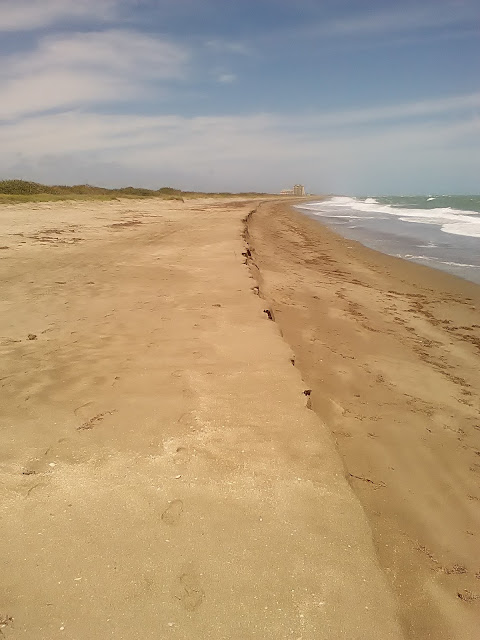Written by the TreasureGuide for the exclusive use of treasurebeachesreport.blogspot.com.
 |
| John Brooks Saturday Afternoon. |
This is one place along the Treasure Coast that shows a cut. Friday I showed the same beach, but nearer to high tide.
 |
| John Brooks Beach Friday Near Low Tide. |
Between Saturday morning and the Friday low tide, another half foot had been added to the cut at John Brooks. The slope was not as mushy either.
Another beach I looked at was not cut at all, but was showing an area that would have probably produced at least some modern coins if I had made the walk. It was a good ways off.
---
From time to time I talk about how beach sand moves. I've referred to how crashing waves push water into the sand and put pressure between particles of sand. I found a good YouTube experiment that hows how water with some velocity saturates and and how the process can actually lift sand particles. You might remember the photo that I posted in which in looked like sand was actually being sucked up into a wave. This experiment might help you better visualize how that happens.
The experiment shows how sand will be moved. If you remember my post on sand liquefaction, this is something like that. The result is "sand shearing." Sand shearing, I recently discovered, is the technical term for one way that sand moves.
 |
| Water Poured Into Sand Contained in a Transparent Container \ Source: YouTube video link below. |
So what does that have to do with metal detecting? Imagine a coin sitting on the surface of the sand when a wave hits the same spot. The coin, unless the force is so great that the coin is lifted too, would slip down into the depression and eventually be covered.
There is another thing to consider as well. When the sand is lifted, it will be easily swept away by water moving over the surface.
On a day when the surf is not so rough, the waves are breaking out in front of the beach. When the waves are bigger and the tide is up, the waves will crash farther up on the beach. When that happens, the sand will wash away quickly.
When the water is hitting with force any type of cliff from any erosion that has already occurred, the erosion will occur quickly due to the water bouncing back off the cliff and washing disturbed sand down the slope at a relatively rapid rate.
On calmer days when the water is washing up the slope, sand and other materials that are easily lifted and moved will wash up onto the slope. The water force will slow as the water goes up the slope and the sand will be deposited. The water washing down the slope will be even less forceful, due to water sinking into the sand.
Here is the link to the video. There is more to it.
https://www.youtube.com/watch?v=nCJLuB0NgcI
If you remember my discussions of trigger points, the water must be moving with enough force to move both sand and coins for coins to wash in. (I'm not talking about coins being uncovered or washing out now.) While the force diminishes, the coins will settle or drop out of the flow while the sand is being moved. The sand will settle out at some other location where the force diminishes even more.
I hope these experiments help you to visualize what I've been talking about. The technical terms make it much easier for me to talk about my observations.
Sand shear or soil shear are two good terms that I'll be using more in the future.
---
It looks like we'll have a three to five foot surf for a few days. The wind will be from the east. That isn't promising, but we'll have bigger tides later in the week.
Happy hunting,
TreasureGuide@comcast.net